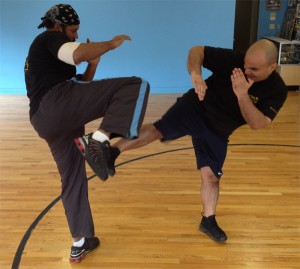 I have been training Wing Chun and teaching for numerous years and I often hear this… “I heard Wing Chun guys don’t kick”. I always get a smile when I hear that. I have also heard after sparring other martial artist from different styles, “I thought Wing Chun guys don’t kick, you kicked the crap out of me”. Basically practitioners got the reputation of not being kickers simple because we do not use fancy kicks. We use effective kicks. Now don’t get me wrong any good kick upside the head can do major damage.
I have been training Wing Chun and teaching for numerous years and I often hear this… “I heard Wing Chun guys don’t kick”. I always get a smile when I hear that. I have also heard after sparring other martial artist from different styles, “I thought Wing Chun guys don’t kick, you kicked the crap out of me”. Basically practitioners got the reputation of not being kickers simple because we do not use fancy kicks. We use effective kicks. Now don’t get me wrong any good kick upside the head can do major damage.
Here is what it comes down to footwork. In every fighting style footwork is the most important aspect. My students have heard me say time and time again and you will too, without good footwork you can not get away from your attack or to your attacker. Footwork is the key to everything else working. So the higher your leg comes off the ground the more balance and mobility you will lose. I have a much better chance of landing a quick kick to my attackers knee that a spinning round kick to their head.
Another concept of a wing chun fighter is targeting. One of these targeting aspects is mobility. If they can’t walk they can’t fight or chase after you. So targeting low can be extremely effective and gets your foot back on the ground where you need it. The only reason I said can be effective is you can always miss.
When we do full contact sparring there is a rule in my school no kicking below the waste. Huh? I thought you said…?
It comes down to safety. Everyone has to go to work or school or do something the next day that involves walking. To name a few reasons we train full contact sparring is to judge range, distancing, speed, and to feel what it is like to hit and get hit not to get permanently injured. It also gives you a place to practice throwing higher level kicks in a safe environment to experiment with what you are capable of doing. If you can throw a solid front kick to the chest then delivering one to the leg will not be an issue.
I have students practicing attacking the legs enough in a safe training environment to avoid unnecessary injury. It is just way to easy to blow out someones knee because you miss judged or they stepped in and that is why Wing Chun loves low kicks because if they are performed right they are dangerous.
Let me leave you with one last note. The best kick is the kick they did not see coming. It is all about timing.

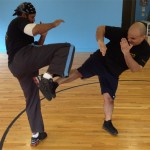
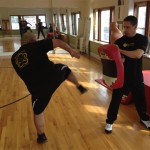
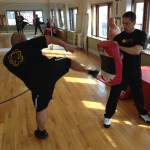
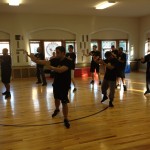
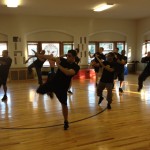
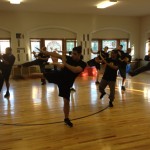
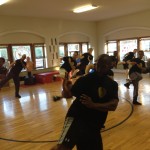
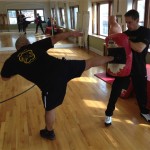
I agree in heavy, full contact sparring you have to be very careful with kicks below the waist, particularly to the knee or if your not wearing a cup, the groin as well. Where I train, we allow both low and high kicks in sparring (and I usually don’t wear gear) – and I have been kicked in the balls so hard a couple times I fell to the ground and couldn’t get up for at least a couple minutes (by the way, if you do get kicked in the balls, an interesting acupressure technique I have learned is to rub the “bubbling wells”, which are the centers of the bottom of your feet, in a circular motion – this is a technique that helps influence your kidney qi, which is heavily tied into your reproductive system).
To make a long story short, if you choose to include kicks below the waist in your sparring, you may have to pay for it. I have physically paid for alot in my training, I’ve even broken an arm during full contact sparring – but ultimately you can’t really keep it “old school” without some blood, sweat and tears. That’s just the way it is – most people don’t want to go that hard or take much risk, which is fine – but your training will not be the same as such hardcore training.
I think it’s important to at least use your kicks to some extent during sparring, or you’re not likely to become highly skilled in actually applying them. It’s one thing to know how to perform the technique, and even performing it in drills with a partner you can get down the distancing and whatnot. In my opinion though, you do need to practice them in sparring to really know when to use them and when not to use them (whether it’s used as an attack, counter attack, or feint), as well as develop proper timing with them.
However, after having experienced alot of pain and suffering in my sparring, I prefer to do light sparring most of the time these days, too much heavy sparring is likely to lead to injury which will further set back the progress of your combat skill and training. Even in light sparring, it’s easy for beginners to make a mistake, and sparring is something that should be done once you’re well coordinated enough to have enough control that you can tap the opponents openings instead of destroying them. So in the end, I believe if you truly want to become an outstanding wing chun fighter, you should use them while sparring to some extent even if it’s only very lightly. If you don’t have the proper control to use them lightly, be patient and wait until you’re ready. If you aren’t able to determine if you are ready, your sifu should be able to let you know.